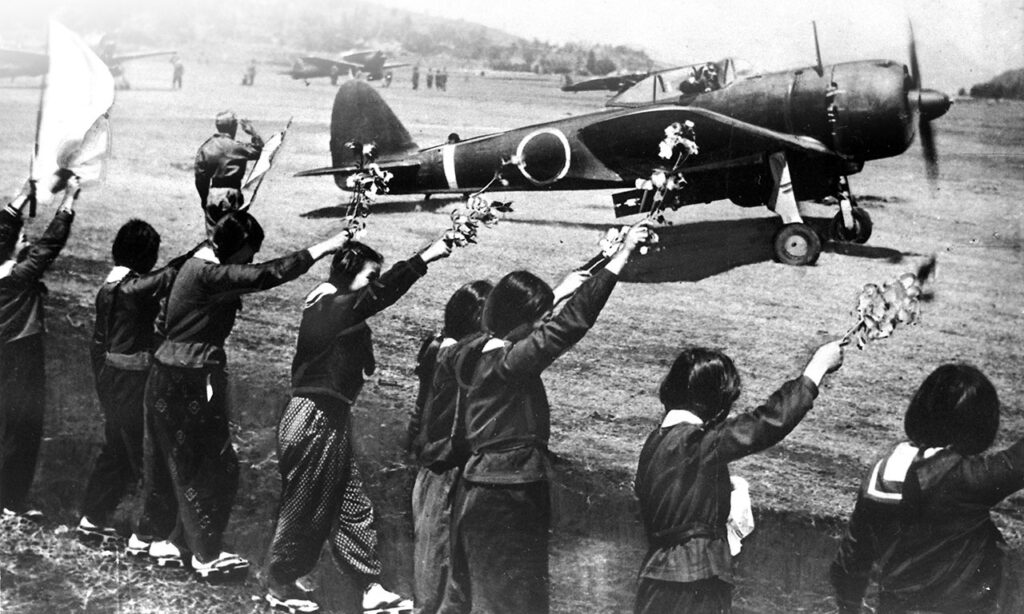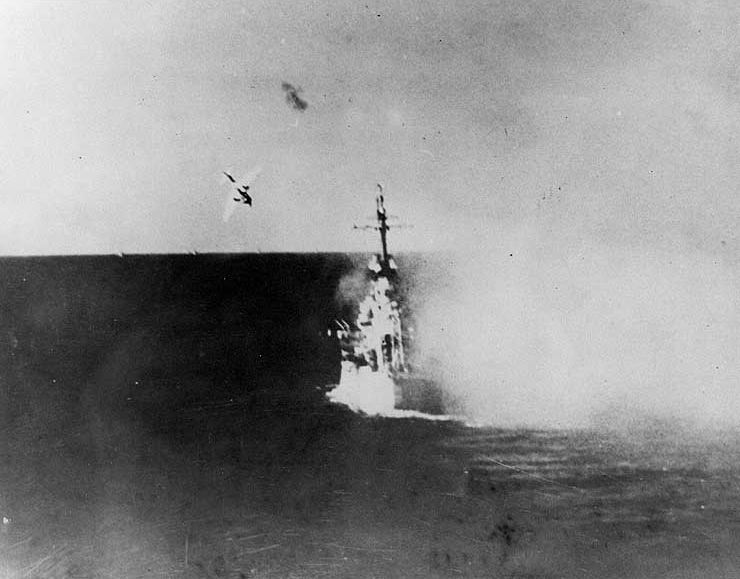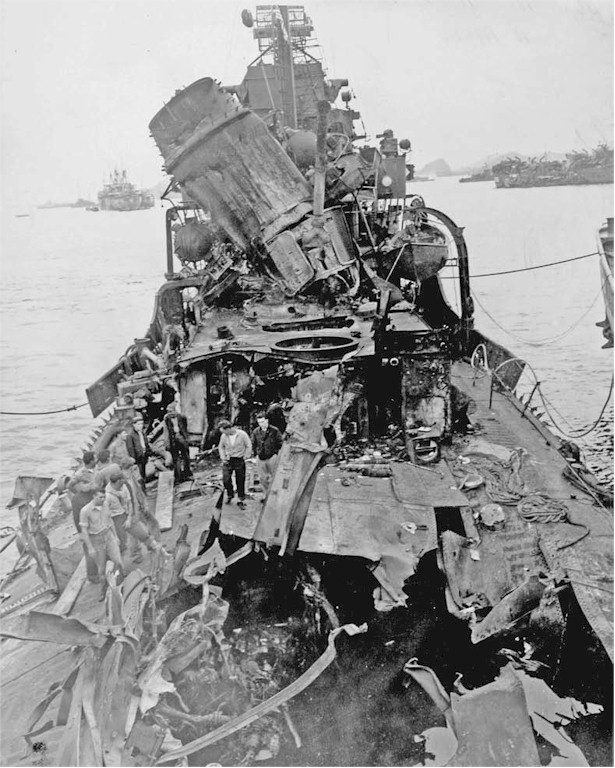
Japan’s kamikaze pilots are nearly synonymous with the country’s war effort during World War Two, especially in the West.
As many myths and misconceptions regarding the kamikaze abound as do questions.
So, who were the men who sacrificed their lives for what they believed to be a brighter future for their country?
Did they genuinely volunteer to die in the line of service, or were they pressured into joining the Japanese airforce’s kamikaze units? And, how effective were their efforts?
Japan in Dire Straits
The Japanese word kamikaze means divine wind, and, as a name, derives from a series of typhoons that devastated an invading Mongolian fleet way back in the 1200s, ultimately driving them to abandon their campaign and leave Japan altogether.
It was hoped that, by invoking the name of the kamikaze storm, Japanese pilots who flew in so-called ‘kamikaze’ suicide missions would receive some form of divine blessing to guide them in their final flight.

Kamikaze pilots were essentially used as a last-ditch attempt to turn the tide of Japan’s campaign against the Allies in the Second World War, especially the US.
In 1944, the Allied Forces made substantial headway in the Pacific theatre.
Their aircraft were newer and more advanced than what the Japanese airforce had access to, and, as a result of mass Japanese casualties, which wiped out most of the country’s most proficient pilots, their men were generally far better-trained and better-equipped by this stage of the conflict, too.
Not long after this, the major Japanese base of Saipan was captured by the US on July 15, 1944. This was a turning point in the War – the base was one of real strategic importance for Japan.
US forces would subsequently use Saipan as a hub from which to move towards the Japanese home islands, and it was suspected that the Allied forces would target the Phillippines next.
Haemorrhaging casualties, plagued by tropical illnesses, short on fuel and spare parts, but totally unwilling to surrender to the Allies, Japan’s airforce needed a new approach to combat that could level the playing field with the better-prepared Allied forces.

It was the Japanese naval Captain Motoharu Okamura who first conceived of the idea of conducting suicide attacks on Allied warships, and he stated “I firmly believe that the only way to swing the war in our favour is to resort to crash-dive attacks with our planes….
There will be more than enough volunteers for this chance to save our country.”
Not only did Okamura believe that there would be ample volunteers for this initiative, but he was aware that a pilot deliberately crashing into his target could generally strike it with far greater accuracy and cause significantly more damage than more traditional air attacks could.
So it was, then, that Japan deployed its first kamikaze pilots in the Pacific during the final stages of the Second World War. The state also used or planned to use, suicide attacks by submarines, speedboats, torpedoes, and divers.
All in all, some 3,800 kamikaze pilots died during their attacks, and they caused the Allied Forces upwards of 7,800 naval casualties.

Kamikaze pilots would often fly specialised aircraft, which were essentially piloted missiles, but they were also known to use standard warplanes.
Who Were The Kamikaze Pilots and Were They Really ‘Volunteers?’
The vast majority of kamikaze pilots were, in fact, volunteers, who had intended expressly to join one of the Japanese airforce’s kamikaze squads. These men were typically in their early 20s, and most of them had never seen active combat before.
Reportedly, it was common for kamikaze pilots to believe that they would be reincarnated as birds or other animals upon dying in service.
It’s worth noting that there was considerable propaganda in Japan at the time surrounding the kamikaze program, and young men faced intense social pressure to volunteer to join it.

The fact that Japan was losing the battle against the Allies was, at the very least, understood at the time, and popular belief held that kamikaze pilots had the potential to change the course and outcome of the War altogether.
Nevertheless, there were plenty of volunteers for the program; reportedly, for every kamikaze aircraft, there were three men who had registered to take part in suicide missions.
Some Japanese airforce commanders have regretfully described how, during the war, if there were too many men for a given kamikaze sortie, they would encourage extra men from that particular unit to join the pilot in the passenger’s seat. This undoubtedly resulted in many completely unnecessary deaths.
Much has also been made of the psychological impact the notion of participating in a suicide mission had on the kamikaze pilots.

Allegedly, many of the pilots would enter a state of incredible bliss before their final sortie, and, were they unsuccessful in their suicide mission, or if it were cancelled, it was common for the men to become totally despondent.
First Kamikazes Deployed
On the 25th of October, 1944, the first-ever kamikaze attack was deployed during the Battle of Leyte Gulf.
In this instance, the decision to utilise such extreme tactics was motivated by the American offence proceeding more or less unimpeded in the face of Japan’s more conventional forms of air attack.

The first kamikaze force was made up of 24 volunteer pilots from Japan’s 201st Navy Air Group. They targeted US escort carriers, and, as part of these attacks, the U.S.S. St. Lo was ultimately sunk.
As a result of their successes, the kamikaze program was expanded significantly and became a more prominent part of the Japanese airforce’s strategy against the U.S. in the Pacific theatre.
How The Kamikazes Were Trained And How They Operated
Before they were sent to the front, kamikaze pilots underwent incredibly strenuous and brutal training, generally lasting between one and two months.
Trainee pilots would often be beaten as a means of strengthening their fighting spirit, but, in many cases, this often had the effect of crushing their morale and sense of national pride.
Trainee kamikaze pilots were also given detailed instruction manuals that outlined how they should carry out their attacks.

Not only were the pilots told not to close their eyes at any point, as this would impede their accuracy, but they were also taught about the most vulnerable parts of ships and air carriers to target.
Typically, kamikaze pilots would essentially dive bomb their target, releasing any onboard munitions at the last second before crashing at incredibly high speeds.
Naturally, this allowed even the poorly-trained kamikaze pilots, many of whom were university students prior to volunteering, to cause massive amounts of destruction during their raids.
As their campaign rolled on, the Allies learned how best to neutralise the threat of kamikaze attacks and were often able to intercept such raids before they found their target.
This was made easier by the fact that kamikaze pilots often flew poorly-maintained aircraft that were in bad condition.
Kamikaze In Retrospect
The number of ships sunk by the kamikaze pilots, as well as the overall effectiveness of their approach, has been debated widely.

One estimate puts the number of ships sunk by kamikaze attacks at 34, and at Okinawa, they reportedly caused the U.S. Navy a staggering 5,000 casualties.
Romanticised notions of the kamikaze pilots have been co-opted by Japanese nationalists in the post-war period as part of political propaganda. Critics have been highly sceptical both of these efforts and of the rose-tinted attitude in Japan towards kamikaze in general, often stressing that many of the volunteers for the initiative faced great pressure to go to the front.
In any case, kamikaze pilots who were unable to complete their suicide missions were met with heavy social stigma for decades after the War had ended.
This has changed in recent years as discourse surrounding the issue has shifted to highlighting the subjective experience and stories of the young men who sacrificed their lives participating in kamikaze raids.
Reportedly, the Japanese use of kamikaze pilots and similar tactics even played a role in President Truman’s decision to use atomic bombs to attack the cities of Hiroshima and Nagasaki.
It was evidently clear to Truman that a U.S. invasion of Japan would be incredibly destructive and bloody, likely causing massive amounts of unnecessary casualties (Japan had reportedly set aside a large number of kamikaze in the event that the U.S. were to invade).

As such, he decided to put an end to the conflict by levelling Hiroshima and Nagasaki, forcing Japan to surrender.
After learning of Japan’s surrender to the U.S., Takijirō Ōnishi, who was then admiral of the Imperial Japanese Navy, committed ritual suicide via seppuku at his place of residence.
Ōnishi was a major proponent of Japan’s kamikaze program, and he left a note apologising to the young pilots he’d effectively sent to die in vain under his command.
Ōnishi then went on to encourage the youth of the nation to focus their efforts on rebuilding Japan and fostering peaceful relationships with other countries. Reportedly, it took over 15 hours for the Admiral to succumb to the injuries he had inflicted on himself eventually.
His suicide was witnessed by Yoshio Kodama, who was Rear Admiral of the Japanese Imperial Navy at the time. Kodama was unable to bring himself to commit seppuku and, having survived the War eventually went on to become a major figure in Japan’s organised crime underworld.
Though, somewhat ironically, a kamikaze-style attempt on his life was made by the Japanese ultranationalist Mitsuyasu Maeno, who crashed a plane into the second floor of Kodama’s home. Kodama was reportedly in a different part of the house when this occurred and was unharmed in the incident.
If you like this article, then please follow us on Facebook and Instagram.